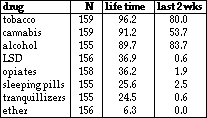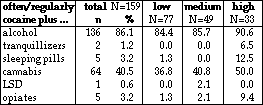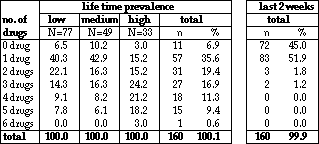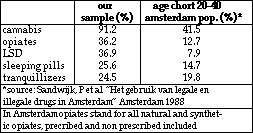Cohen, Peter (1989),
Cocaine use in Amsterdam in non-deviant subcultures. In: Peter Cohen (1990),
Drugs as a social construct. Dissertation. Amsterdam, Universiteit
van Amsterdam. pp. 110-113.
© Copyright 1990 Peter Cohen.
All rights reserved.
6. Combination of cocaine with other drugs
Peter Cohen
Table of contents
6.1 Introduction
In this chapter we will investigate cocaine use in combination with other drugs by members of our sample. The use of opiates in combination with cocaine occurs relatively seldom in our sample compared to the Miami sample of cocaine users.
We will show that cocaine users in our sample have much more experience with drugs than their age cohort in the general Amsterdam population.
6.2 Apart from cocaine
Before showing the combinations of drugs our respondents reported using, we will give an overview of the raw prevalence of other drugs used by the sample.
Respondents were asked to report lifetime prevalence and last two weeks prevalence of alcohol, tobacco, tranquillizers, sleeping pills, cannabis (marihuana and hashish), LSD, ether and opiates.
Most of these drugs were used in combination with cocaine, albeit in quite different patterns. Alcohol, tobacco and cannabis are the three most often used drugs, apart from cocaine (which, automatically, has a life time prevalence of 100%).
In Tables 6.2.a and 6.2.b we clearly see that alcohol, tobacco and cannabis are not only the drugs with the highest life time and last two weeks prevalence, but that they are also most often used in combination with cocaine. All other drugs are insignificant in this respect.
This changes somewhat, when we crosstabulate the use of combinations of cocaine plus another drug with level of cocaine use, as measured during the period of heaviest use.
Table 6.2.a Life time prevalence and last two weeks prevalence of other drugs, in % of total sample

Table 6.2.b The use of cocaine plus another drug, in %

We then find the following, after summation the 'often' and 'regularly' categories from Table 6.2.b.
Table 6.2.c Often or regularly used drugs, in combination with cocaine, differentiated for level of cocaine use during period of heaviest use

The high level users of cocaine (during the period of heaviest use) show a markedly higher use of tranquillizers (6.5% vs 1.2%), sleeping pills (12.5% vs 3.2%) and opiates (9.4% vs 3.2%) in combination with cocaine than is the case for the total sample. The extremely small cell sizes makes it difficult to freely generalize from these data, but there is some indication that high level use of cocaine is related to a higher combinational use of sedative drugs. What this relation might look like is impossible to infer from these data.
The high level users (during period of heaviest use) distinguish themselves also in polydrug use, in that they more often report a life time prevalence of more drugs, as can be seen in Table 6.2.d. We excluded the use of alcohol and tobacco, as these drugs are used by almost everyone, also in the last two weeks (see Table 6.2.a).
Table 6.2.d Life time prevalence and last two weeks prevalences of other drugs than cocaine, alcohol and tobacco, in %

The high level cocaine users (during period of heaviest use) also score higher when we look at life time prevalence of having used three or more drugs, although there are very few of them.
The right column of Table 6.2.d shows a comparison between lifetime and last two weeks prevalence of drug use other than cocaine, tobacco and alcohol.
Polydrug use in the last two weeks is much lower than life time prevalence. The principal drug is cannabis, which was used in the past two weeks by 82 persons (51%).
We are able to compare those drugs used in Miami, Amsterdam and Toronto in combination with cocaine. In the Miami study these data are reported for each ethnic group that participated. In this case we can compare other drug use for the white subsample of the Miami study, not controlled for treatment or non treatment. See Table 6.2.e.
Such a comparison clearly shows that the drug using populations from which the respondents have been recruited are very dissimilar. The Miami sample has a high prevalence of "narcotics" and a high prevalence of injecting and free basing (see chapter 5). This is interesting because it illustrates how extremely important it is not to generalize drug use patterns from one group to another.
When we compare lifetime prevalence of the use of drugs apart from alcohol and tobacco between our sample and the age cohort 20-40 years in a representative sample from the population of Amsterdam we clearly see a big difference between the two samples. More of our cocaine users have experience with other drugs than a similar age cohort in the general population.
Table 6.2.e Other drugs, ever used in combination with cocaine, in Amsterdam, Miami and Toronto, in %

Table 6.2.f Life time prevalence of other drugs than tobacco and alcohol in in our sample of cocaine users and in general sample (age 20-40) in the Amsterdam population; in %

